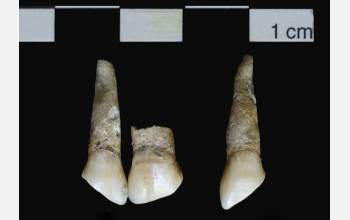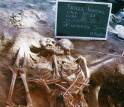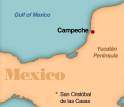News Release 06-019
Excavated Teeth Likely Came from First Africans Brought to the New World
Europeans may have imported slaves in the 1500s

Teeth recovered in a Campeche graveyard show evidence of the African practice of filing.
January 31, 2006
This material is available primarily for archival purposes. Telephone numbers or other contact information may be out of date; please see current contact information at media contacts.
Forensic details obtained from human teeth excavated from a church graveyard in Mexico suggests Europeans brought slaves from Africa to the New World as long ago as the late 1500s to work as servants and on the docks of coastal Central America. According to a report to be published in an upcoming issue of the American Journal of Physical Anthropology, the teeth came from people born in Africa and who were probably among the first slaves brought to the Americas.
"It does mean that slaves were brought here almost as soon as Europeans arrived," said T. Douglas Price of the University of Wisconsin-Madison.
Price and coworker James H. Burton of UW-Madison, and Vera Tiesler of the Autonomous University of the Yucatan, measured a radioactive substance known as strontium in teeth recovered from an early colonial burial ground in Campeche, Mexico, located on the gulf shore of the Yucatan Peninsula. Strontium isotopes are normally found in the soil, but make their way into the food supply when they are dissolved and taken up by plants. Because the substance concentrates in teeth and bones of people and animals that eat the plants, strontium has become a reliable marker not only of the age of human remains but also of their geographic origin.
The National Science Foundation funded the work.
Radioactive strontium in teeth is particularly useful for determining birthplace, because teeth form during gestation and early childhood. The type of strontium found in teeth mirrors that deposited in the bedrock of the area where a person was born. By comparing the isotopes in teeth recovered from the graveyard with known strontium values for geologic regions around the world, the scientists were able to determine if the individuals were born in Africa or the New World.
The values Price and his coworkers found in the teeth "coincides closely with the region inland from the Gold Coast," the report says, "infamous as the center of the African slave trade during the late 16th and 17th century."
"These individuals are likely to be among the earliest representatives of the African Diaspora in the Americas, substantially earlier than the subsequent, intensive slave trade of the 18th century."
Read the University of Wisconsin press release.
-NSF-
-
Scientists believe these are the oldest remains of slaves brought from Africa to the New World.
Credit and Larger Version -
Evidence from Campeche, Mexico, places Africans in the New World in the late 1500s.
Credit and Larger Version
Media Contacts
Leslie Fink, National Science Foundation, (703) 292-5395, email: lfink@nsf.gov
Terry Devitt, University of Wisconsin, (608) 262-8282, email: trdevitt@wisc.edu
Program Contacts
John Yellen, National Science Foundation, (703) 292-8759, email: jyellen@nsf.gov
Principal Investigators
T. Douglas Price, University of Wisconsin, (608) 262-2575, email: tdprice@wisc.edu
The U.S. National Science Foundation propels the nation forward by advancing fundamental research in all fields of science and engineering. NSF supports research and people by providing facilities, instruments and funding to support their ingenuity and sustain the U.S. as a global leader in research and innovation. With a fiscal year 2023 budget of $9.5 billion, NSF funds reach all 50 states through grants to nearly 2,000 colleges, universities and institutions. Each year, NSF receives more than 40,000 competitive proposals and makes about 11,000 new awards. Those awards include support for cooperative research with industry, Arctic and Antarctic research and operations, and U.S. participation in international scientific efforts.
Connect with us online
NSF website: nsf.gov
NSF News: nsf.gov/news
For News Media: nsf.gov/news/newsroom
Statistics: nsf.gov/statistics/
Awards database: nsf.gov/awardsearch/
Follow us on social
Twitter: twitter.com/NSF
Facebook: facebook.com/US.NSF
Instagram: instagram.com/nsfgov




